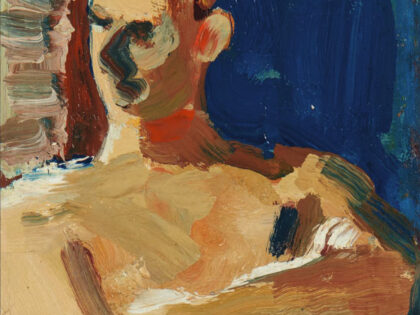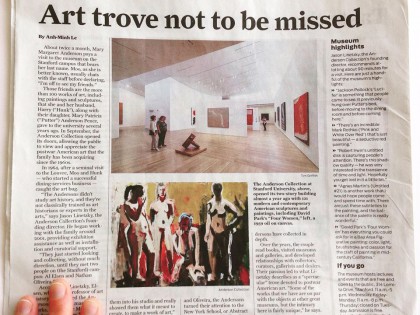A different aspect of the Anderson Collection on view
Visitors to the Anderson Collection at Stanford University can experience a wide range of art movements (virtually every major development after 1945) and media. The museum founders, Hunk and Moo Anderson, did not collect photography but nearly every other means of artistic expression are represented, including works on paper. The museum is shining a light on this aspect of the Anderson’s collecting with an exhibition, “Salon Style: Collected Marks on Paper,” that features drawings, collages and paintings. These works, on display until Aug. 20, are not part of the original gift of 121 works to the museum, but are included in the private holdings of the Anderson Collection located at the Quadrus site on Sand Hill Road.
According to Anderson Collection Director Jason Linetzky, the idea for the exhibition came after conversations with the Andersons, who “wanted to expand our visitor’s experience and understanding of works and artists in the collection.” The show, which is dedicated to Hunk Anderson (he passed away in February at the age of 95), is the first in a series of two exhibitions that will feature works on paper created by some of the most important artists in the collection.
“Hunk, Moo and Putter (their daughter) place equal attention and value on ‘drawing’ and all were excited about exhibiting works from their collection that would offer museum visitors a deeper look into the work of collection artists,” explained Linetzky. For this first exhibition, artists working in post-war America were chosen. Included are: Richard Diebenkorn, William Baziotes, Sam Francis, Helen Frankenthaler, Philip Guston, Arshile Gorky and Mark Rothko. Linetzky said that many of the paper pieces were created earlier than paintings found upstairs in the permanent collection.
“These works give visitors a sense of where the artist came from and help to contextualize (i.e,, Guston) or provide a deeper look (i.e., Diebenkorn). In the case of Guston, where else can you find a 30-year cross-section of amazing works to help contextualize the two permanent collection works (dated 1962 and 1977)?” When asked if he thought it was important for viewers to make a connection between the art on paper and those pieces hung in the permanent galleries, Linetzky responded, “Yes, for example, I hope visitors see the early Rothko drawing and relate it to his later, mature paintings.”
As indicated by the title, the exhibition is hung in the “salon style,” which usually means grouping and stacking art work as was done in 19th-century museums and art academies. It also relates to the intimate, casual manner in which the Andersons displayed art in their home. Subdued lighting (to protect the fragile art on paper) sets a quiet mood and the small selection allows the visitor to linger and take in each work individually. Sometimes the connections are easily made. For example, Franz Kline’s “Untitled (Dancer at Islip)” uses the same bold, black, gestural strokes that can be seen in his paintings. Richard Diebenkorn’s carefully composed use of geometry and muted, cool colors relates directly to the evocative “Ocean Park #60” at the top of the steps. On the other hand, Ad Rhinehart’s “Untitled”, a gouache on paper, is a complete surprise. Unlike “Abstract Painting, 1966,” which consists of subtle gradations of black tones, the work on paper is an abstract composition featuring eye-popping strokes of bright red and blue.
Sam Francis used his signature splashes of primary colors to embellish the almost childlike depiction of himself. Conversely, Arshile Gorky used graphite and pastels to capture a stern and serious visage. Ellsworth Kelly employed ink on paper to portray himself in a contemplative pose, while Franz Kline’s dark, pensive face is branded with a large black “K.” All provide insights into the persona of the artist, which increases visitors’ appreciation of the art work installed in the upstairs galleries.
There is only one woman represented in this small show but she is certainly a significant inclusion in this and any museum collection. Frankenthaler was one of the first to break away from the angst-ridden, paint-flinging style of the Abstract Expressionists. It is said that she initiated the practice of pouring thinned-down oil paint onto unprimed canvas, resulting in a fusion of surface and color (which later would be called “color-field painting”). Her “Monotype VII” has the same energetic feeling as “Approach” upstairs. In the painting, the staining is applied sparingly, so as to create more perspective space. The monotype, however, is a joyous expanse of color punctuated by tiny flashes of white that remind one of fireworks over the ocean.
Linetzky said that the second exhibition, which will open in September, will feature more contemporary works by artists based in California. Most likely to be included are: Bruce Conner, Wallace Berman, Jay DeFeo and Ed Ruscha.
As part of the Anderson Collection Sharing Program, works like these (there are more than 300 works on paper) can be loaned to the campus museum, and to other institutions. Temporary exhibitions like this ensure that the museum is a vital and dynamic place where visitors will keep learning more, both about the art and artists on display, and the collectors who made it all possible.
Freelance writer Sheryl Nonnenberg can be emailed at nonnenberg@aol.com.
What: “Salon Style: Collected Marks on Paper.”
Where: Wisch Family Gallery, Anderson Collection, 314 Lomita Drive, Stanford.
When: Through Aug. 20. Museum hours are Wednesday-Monday from 11 a.m. to 5 p.m. (Thursday open until 8 p.m.).
Cost: Free.
Info: Go to Anderson Collection.






